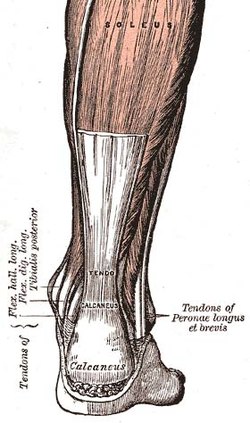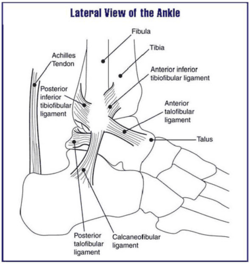Achilles tendon
| Achilles tendon | |
|---|---|

Posterior view of the foot and leg, showing the Achilles tendon (tendo calcaneus). The gastrocnemius muscle is cut to expose the soleus.
|
|

Lateral view of the human ankle, including the Achilles tendon
|
|
| Details | |
| Identifiers | |
| Latin | tendo calcaneus, tendo Achillis |
| MeSH | A02.880.176 |
| TA | A04.7.02.048 |
| FMA | 51061 |
|
Anatomical terminology
[]
|
|
The Achilles tendon or heel cord, also known as the calcaneal tendon (Latin: Tendo calcaneus), is a tendon of the back of the leg, and the thickest in the human body. It serves to attach the plantaris, gastrocnemius (calf) and soleus muscles to the calcaneus (heel) bone. These muscles, acting via the tendon, cause plantar flexion of the foot at the ankle, and (except soleus) flexion at the knee.
The tendon can rupture and become inflamed.
"Achilles' heel", referring to a vulnerability, relates to the mythical story of Achilles, an ancient Greek war hero who, as a baby, was dipped into a river by his mother to gain a magical coating of invincibility. Because Achilles's mother held her son by one heel as she put him into the river, the heel was not exposed to this protective coating and therefore remained his one site of vulnerability.
The Achilles tendon connects muscle to bone, like other tendons, and is located at the back of the lower leg. The Achilles tendon connects the gastrocnemius and soleus muscles to the calcaneal tuberosity on the calcaneus (heel bone). The tendon begins near the middle of the calf, and receives fleshy fibers on its inner surface, almost to its lower end. Gradually thinning below, it inserts into the middle part of the back of the calcaneus bone. The tendon spreads out somewhat at its lower end, so that its narrowest part is about 4 centimetres (1.6 in) above its insertion.
...
Wikipedia
